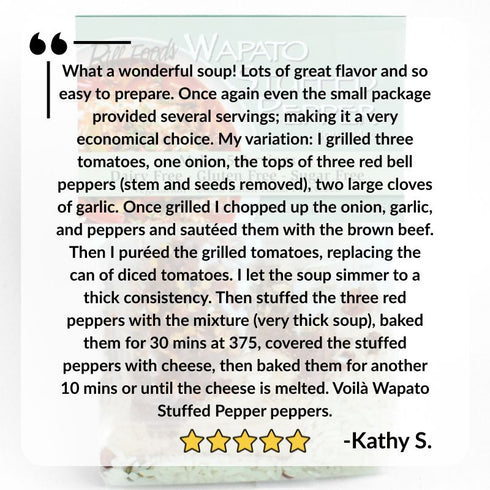Available in 4 oz and 8 oz packages
Cooking Time
35 minutes
Serving Size
10 cups
Kettle Size
4 quarts
Ingredients
Rice, green and red bell peppers, herbs and spices, beef base, dehydrated celery and carrots, crushed red pepper.
Available in small and large packages
Small: 4-5 1 cup servings
Large: 8-10 1 cup servings
Nutritional Facts for small package: Serv. Size 1 cup, Servings 5 Amount Per Serving: Calories 120, Fat Cal 0, Total Fat 0g (0% DV), Sat Fat 0g (0% DV), Cholest.0mg (0% DV), Sodium 320mg (13% DV), Total Carb. 22g (7% DV), Fiber 6g (24% DV), Sugars 3g, Protein 7g, Vitamin A (8% DV), Vitamin C (15% DV), Calcium (4% DV), Iron (15% DV). Percent Daily Values (DV) are based on a 2000 calorie diet.
 Product of Washington State
Product of Washington State

Rill's Specialty Soups are a Product of Washington State.
Great Ideas for Dressing Up your Wapato Stuffed Pepper Soup
| Add |
Stewed tomatoes In place of grated Try your favorite sausage in place of ground beef |
| Serve | in a bread bowl for a great presentation |
| Vegetarian | Remove beef base packet and substitute vegetable broth |
Tidbits of History - Wapato (Wah’-puh-toh)
The town of Wapato lies in the South Central part of Washington State on the Yakima Indian Reservation. The name Wapato is a Native American word for a plant commonly dug for its starchy roots, something like a potato. In the early 1900s when it became legal to gain clear titles to Native American lands, Alex McCredy bought 80 acres and platted the town site. White farmers began to buy and lease reservation lands, and with the aid of Japanese laborers they turned the sagebrush desert into productive lush farms. The Japanese were brought in by Northwest Development Company and they tended the first apple orchard on the Yakima Reservation. This became possible with the help of government irrigation projects.
In the early 1920s Filipinos began immigrating to the Yakima Valley. They came with special immigration status as citizens of an American Territory and had high hopes of pursuing higher education. They began to work together in co-ops for mutual social and economic benefit buying land when they were able. During the great depression, some people became resentful of outsider laborers, which they viewed as job competitors. It is recorded that a gang of hooligans drove from house to house dragging Filipino farmers from their beds and beating them. Some were forced into freight trains bound for Seattle. With their determination to stay they remain in the community today.
One third of Wapato’s current population is now Latino. This shift began during WWII when Yakima Valley farmers were in great need of workers. Most of the American young men were in the armed services, many wage earners had gone to defense plants on the coast, and the Japanese American farmers had been sent to relocation centers. The federal government set up the Bracero Program, which allowed Mexican laborers to enter the United States on a temporary basis for the harvest season.
Today, Wapato is a small community with diverse ethnic heritage. In the fall, people come from all over the state to purchase fruits and vegetables during the harvest season. The area also grows many types of peppers, mint, hay, and hops.
Free Shipping -
All orders of $50 or more qualify for free shipping excluding Traxxas RC vehicles. RC vehicles ship for $9.99 - $12.99 each (in-state vs. out of state).
Free Local Delivery -
Within Kittitas County (M-F)
Returns & 100% Money Back Guarantee -
If within the first 15 days after receiving your order you would like to return your item(s) for any reason, call 509-925-9851 or email Order@Jerrols.com and we will email you a return label to print and use to ship back to us via USPS.






